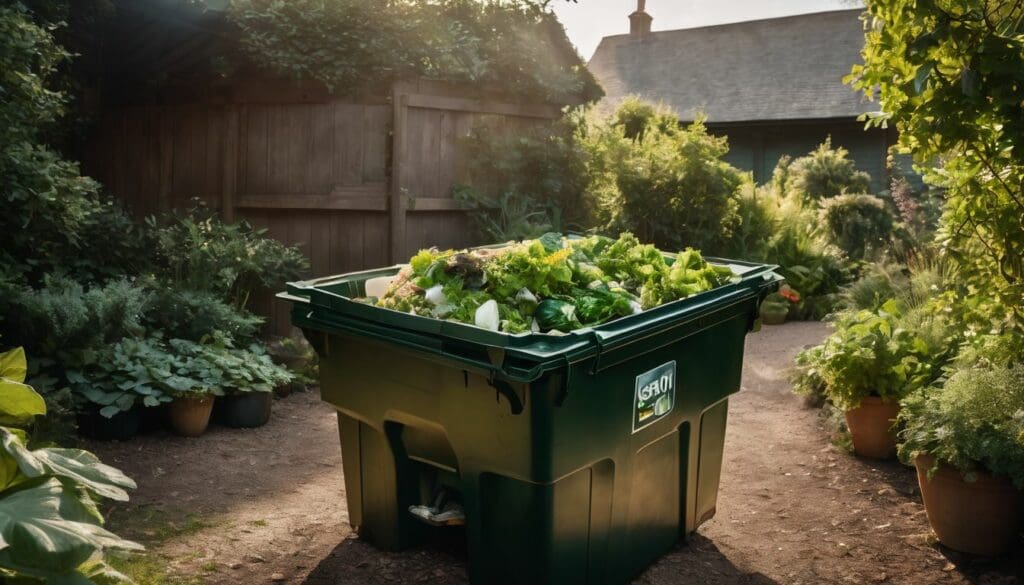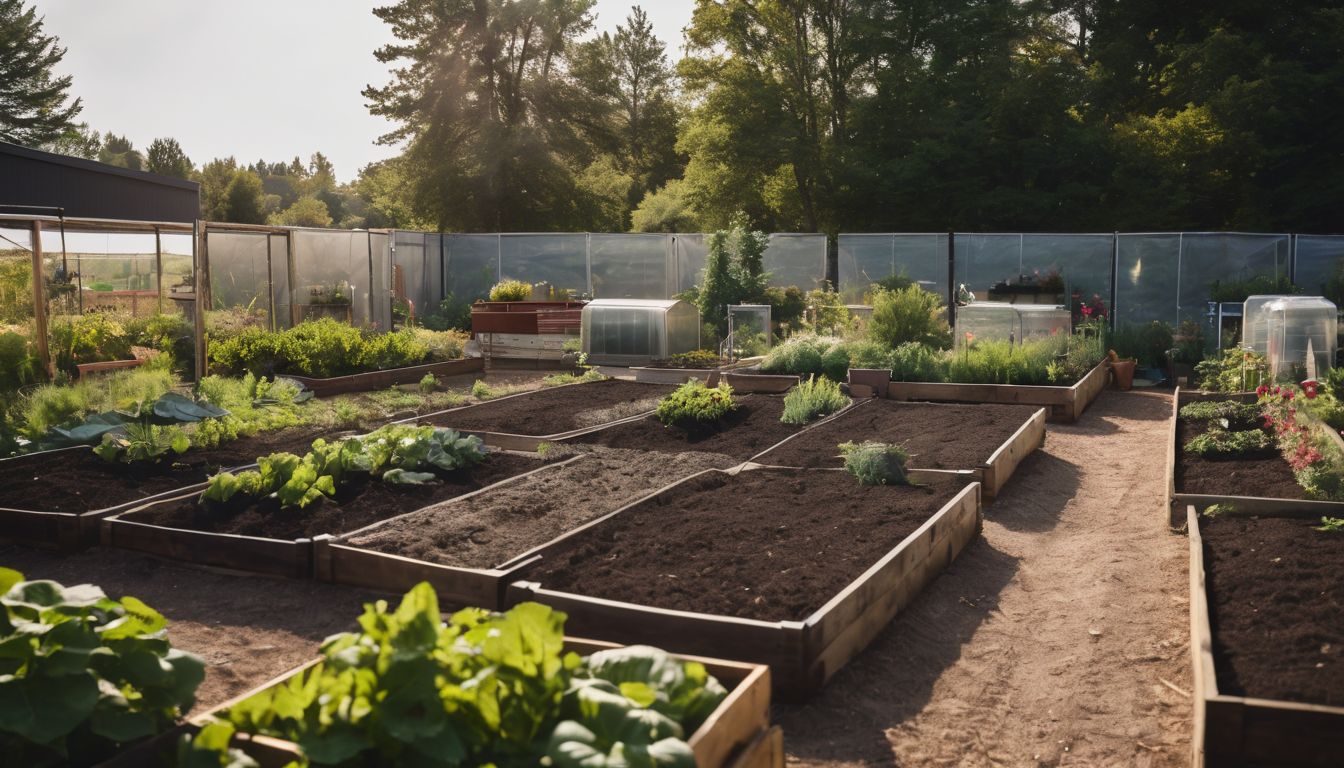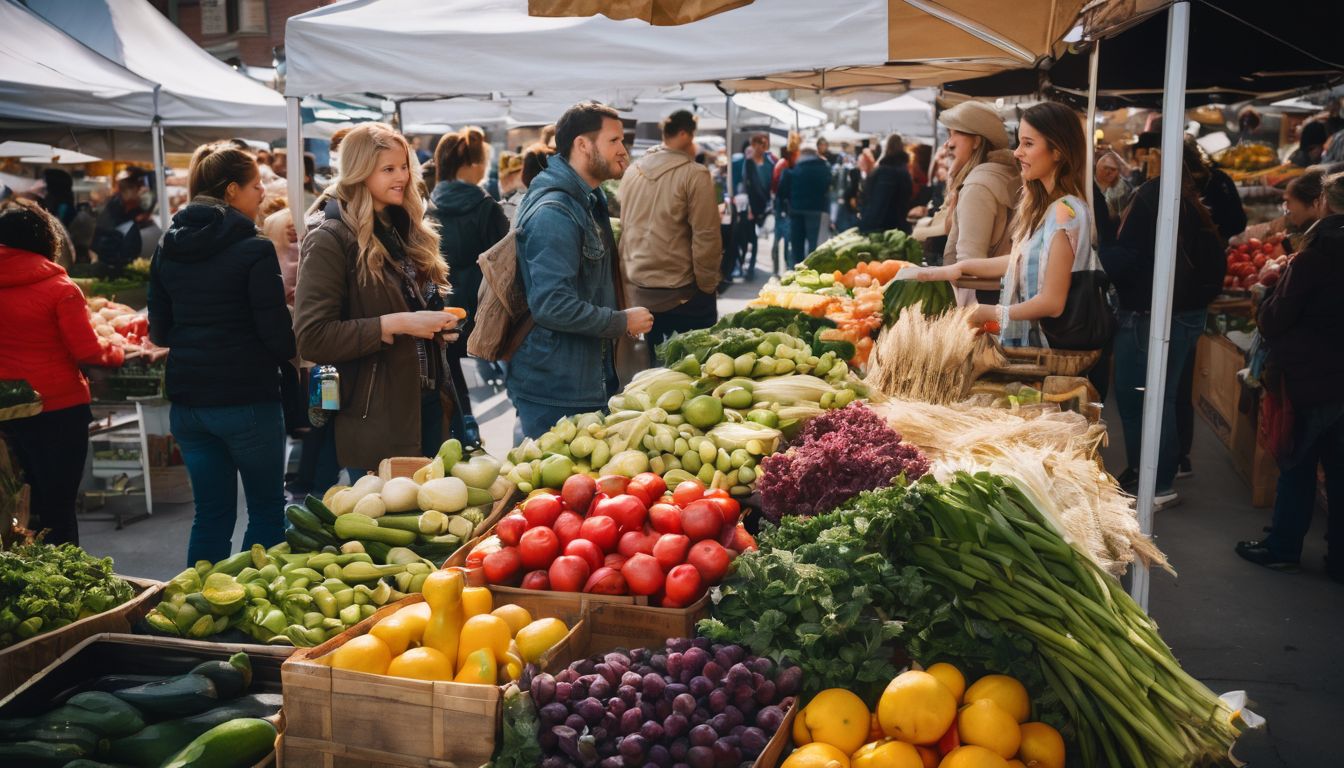Endlessly battling kitchen waste can sometimes feel like a rather Sisyphean task, but fear not – you’re certainly not alone in the fray. It’s quite staggering to think that the average household in the UK consigns around 22 million tonnes of waste to the bin each year.
But here’s your guide, a veritable treasure map if you will, to navigating this issue and turning what might seem like mere scraps into gold for your garden through the magic of composting.
So roll up your sleeves; it’s time we embark on this green-fingered adventure together!
Key Takeaways
- Home composting transforms kitchen and garden waste into nutrient – rich soil, reducing the 22 million tonnes of household waste sent to UK landfills each year.
- Properly maintaining a compost pile involves regular turning, balancing green and brown materials, and ensuring the pile remains moist for optimal decomposition.
- Compost benefits gardens by enhancing soil structure, providing nutrients that promote plant growth, and reducing reliance on chemical fertilisers.
- To start your own compost heap: select a well-drained location away from direct sunlight, layer green and brown materials in alternation, and aerate regularly for efficient breakdown of organic matter.
- Finished compost can be used throughout the year as mulch or mixed with potting soil; it should be stored dry to keep its quality.
Why Compost at Home?
Composting at home has numerous benefits for the environment and your garden. By reducing waste, you can create nutrient-rich soil for your plants while also reducing your carbon footprint.
Benefits for the environment
Turning kitchen scraps and yard waste into compost isn’t just smart gardening; it’s a significant stride toward reducing landfill loads. Every banana peel or handful of fallen leaves we add to our backyard composting system is one less item clogging up waste streams.
We’re creating a cycle that takes organic matter full circle, cutting down on methane emissions from decomposing trash in landfills and leading the way for ecofriendly practices.
By engaging in this nutrient recycling, we’re giving back to the Earth, enriching soils naturally without chemical fertilisers. This supports conservation by helping maintain natural habitats and biodiversity.
Our actions transform waste into wealth for the planet, setting an example for sustainable living. Next, let’s consider how your garden reaps rewards from these efforts.
Benefits for your garden
After enriching the environment with your compost, you can also enjoy the benefits of using it in your garden. The rich nutrients found in compost are excellent for improving soil structure and enhancing moisture retention, making it a perfect addition to vegetable beds, flower gardens, and lawns.
Additionally, by using compost in your garden beds, you are promoting healthy plant growth and reducing the need for chemical fertilisers. This organic waste reduction method not only supports a green living approach but also offers long-term soil enrichment for sustainable home gardening practices.
Reducing waste
Reducing waste is a crucial aspect of home composting. By diverting organic materials from landfills and incinerators, we can significantly reduce the amount of methane gas released into the atmosphere.
This not only helps in minimising greenhouse gas emissions but also contributes to conserving valuable landfill space. Creating nutrient-rich compost from food scraps and yard waste allows us to adopt a more sustainable approach by returning valuable nutrients back to the soil, reducing our overall impact on the environment.
Additionally, incorporating a home composting system decreases reliance on synthetic fertilisers and reduces packaging waste associated with store-bought compost products. This fosters an environmentally-friendly lifestyle that aligns with our commitment to conservation and sustainability.
Setting up Your Composting System
Choosing the right location for your compost bin is crucial to ensure proper airflow and drainage. Consider what materials you will include in your compost, as well as the size and style of compost bin that best suits your needs.
Choosing a location
When selecting a location for your compost bin, pick a spot that is convenient to access but away from direct sunlight. This will help maintain the right temperature and moisture levels for efficient decomposition.
Also, ensure that the area allows for proper drainage while being close enough to your garden or kitchen for easy disposal of organic waste.
Once you’ve chosen a suitable location, consider placing your compost bin on bare soil if possible. This allows beneficial organisms from the ground to enter and aid in the decomposition process.
What to include in your compost bin
To create successful compost, be sure to include a variety of materials in your compost bin. Here are the essential components for a thriving home composting system:
- Green Material: This includes fruit and vegetable scraps, coffee grounds, eggshells, and grass clippings. These items provide nitrogen, which is crucial for the decomposition process.
- Brown Material: Dry leaves, branches, straw, sawdust, and shredded paper are excellent sources of carbon. They help balance the nitrogen-rich green material and provide structure to the compost heap.
- Twigs and Small Branches: Adding these items helps with aeration and creates air pockets within the compost heap.
- Compost Tumbler or Bin: Choose a suitable container for your composting needs. Consider tumblers and bins that provide proper ventilation and insulation to facilitate the decomposition process.
- Vegetable and Flower Beds: Utilise finished compost by applying it to your garden beds to nourish plants naturally.
- Storing and Using Throughout the Year: Properly store finished compost in dry conditions to use it consistently throughout the year for various gardening needs.
Size and style considerations
When selecting a compost bin, consider the available space in your garden and the amount of organic waste you generate. Opt for a size that can accommodate your household’s waste while fitting into the chosen location.
A smaller yard may benefit from stackable bins or tumblers, while larger gardens can house traditional open bins or even dedicated compost heaps. Style-wise, choose a design that complements your outdoor space and is easy to access for adding and removing materials.
To create an efficient system, ensure adequate ventilation, especially if using a closed bin or tumbler. This will help aerate the composting materials and promote decomposition. Additionally, select a style that allows for regular maintenance such as turning or mixing the contents to speed up the process.
Steps for Successful Composting
To start composting successfully, you need to understand the stages of composting, know what materials to include, and learn how to maintain and troubleshoot your pile. Click here to learn more about the key steps for successful composting at home.
The stages of composting
To start the composting process, we gather green and brown materials. We then mix them together in the compost bin or pile to provide a balance of nitrogen and carbon. Over time, microorganisms break down the organic matter, heating up the materials during their metabolic processes.
This is known as the active stage of composting where temperatures can reach 110-160°F (43-71°C). As this stage progresses, you’ll notice a decrease in temperature and a change in material appearance as it turns dark brown and crumbly.
This signals that decomposition is complete.
By aerating your compost regularly with a pitchfork or shovel, you help speed up the process by providing oxygen for aerobic organisms to thrive. A well-aerated pile will also minimise any odours while preventing anaerobic conditions that lead to slower decomposition rates.
What to compost
To create nutrient-rich compost, you can include the following items in your compost bin:
- Fruit and vegetable scraps, including peels and cores.
- Coffee grounds and tea bags.
- Eggshells (crushed for faster breakdown).
- Yard waste such as grass clippings, leaves, and small branches.
- Shredded paper or cardboard (avoid glossy or colored paper).
- Plant trimmings and dead flowers.
- Sawdust from untreated wood.
How to start a compost heap
To create nutrient-rich compost, follow these steps to start a compost heap:
- Select a suitable location for your compost heap that is well – drained and receives sunlight. This will help accelerate the decomposition process.
- Begin the heap with a layer of coarse materials like twigs or straw to promote airflow and drainage within the pile.
- Add a layer of green materials such as grass clippings, fruit and vegetable scraps, and coffee grounds. These provide nitrogen to fuel the decomposition process.
- Alternate the green layers with brown materials such as leaves, branches, and shredded paper to balance the carbon-to-nitrogen ratio in the heap.
- Ensure that each layer is moist but not waterlogged to facilitate microbial activity.
- Turn or mix the pile regularly to aerate it and speed up decomposition.
- Monitor the temperature of the heap with a compost thermometer to ensure it reaches the optimal range for decomposition (between 135-160°F or 57-71°C).
- With time and regular maintenance, your compost heap will transform into dark, crumbly compost ready for use in your garden.
Maintaining and troubleshooting
Maintaining and troubleshooting your composting system is essential to ensure that it functions efficiently and produces high-quality compost. Here are some important steps to help you maintain and troubleshoot your home composting system:
- Turn the compost regularly to aerate it and speed up the decomposition process.
- Keep the compost moist, but not too wet, by watering it occasionally.
- Monitor the temperature of the compost to ensure that it stays within the ideal range for decomposition.
- Add carbon-rich materials if the compost becomes too wet and smelly, or nitrogen-rich materials if it becomes too dry and fails to decompose properly.
- Check for any signs of pests or unwanted critters in your compost bin and take necessary measures to control them.
- Keep an eye out for any foul odors emanating from the compost, which may indicate improper decomposition or excessive moisture levels.
Tips for Using Your Finished Compost
– Applying finished compost to your garden will improve soil structure and provide essential nutrients for healthy plant growth.
– You can also use finished compost as mulch, mix it with potting soil for indoor plants, or create nutrient-rich compost tea to nourish your garden throughout the year.
Applying to your garden
To use your finished compost in your garden, follow these steps:
- Spread a 2 – 3 inch layer of compost on the soil surface around your plants.
- Gently work the compost into the soil using a rake or hoe.
- Ensure that the compost is evenly distributed to provide nutrients to all areas of your garden.
- Water the area thoroughly to help the compost integrate with the soil and activate its benefits.
Other uses for compost
After applying compost to your garden, you can also use it for enriching potting soil. Mix it with commercial or homemade potting mixes to add nutrients and improve soil structure.
Compost can also be used as a top dressing for lawns, adding essential organic matter that promotes healthy grass growth.
In addition, finished compost can be incorporated into erosion control blankets or jute netting to prevent soil erosion on slopes and disturbed areas. The organic material in the compost helps bind the soil together, reducing runoff and promoting vegetation growth.
Storing and using throughout the year
To store compost throughout the year, place it in a dry and well-ventilated area. Keep it covered to protect it from rain and pests. Use a shovel or pitchfork to turn the pile occasionally, helping air circulate and prevent unpleasant odors.
When using your finished compost, apply it as a top dressing for garden beds in spring or autumn. It’s also useful for potted plants, creating nutrient-rich soil for healthy growth.
Additionally, mix compost into potting soil to improve its texture and fertility.
Conclusion
To sum up, setting up a home composting system is a practical and rewarding way to contribute to the environment. By diverting kitchen and garden waste from landfills, you can create nutrient-rich compost for your garden and reduce your carbon footprint.
Taking simple steps like choosing the right location, adding the appropriate materials, and maintaining your compost pile will help you successfully turn organic waste into valuable soil amendment.
Getting started with home composting is easy and makes a positive impact on both your garden and the planet.
FAQs
1. How do I start a compost pile in my yard?
To start a compost pile, collect compost materials like kitchen waste and garden trimmings, select a suitable spot in your backyard, and layer the materials to begin the decomposition process.
2. What should I put in my compost bin when setting up?
When setting up your bin, mix greens such as vegetable scraps with browns like dried leaves or cardboard. These ingredients are essential for creating healthy home-composting systems.
3. Can I build my own DIY compost bin?
Absolutely! Building a DIY compost bin can be simple; use recycled wood or other materials to create an enclosure that allows airflow but keeps contents contained.
4. Is using a compost tumbler better than an open-air pile for beginners?
Using a compost tumbler or enclosed bin can make turning easier and protect from pests; it’s often preferred by beginners who want to maintain tidiness while creating their home system.
5.Can I get a free composter from my local council?
Some councils offer free or discounted bins through recycling programs — check with yours if they provide getting started equipment like bottomless cylinders allowing worms into building waste.





